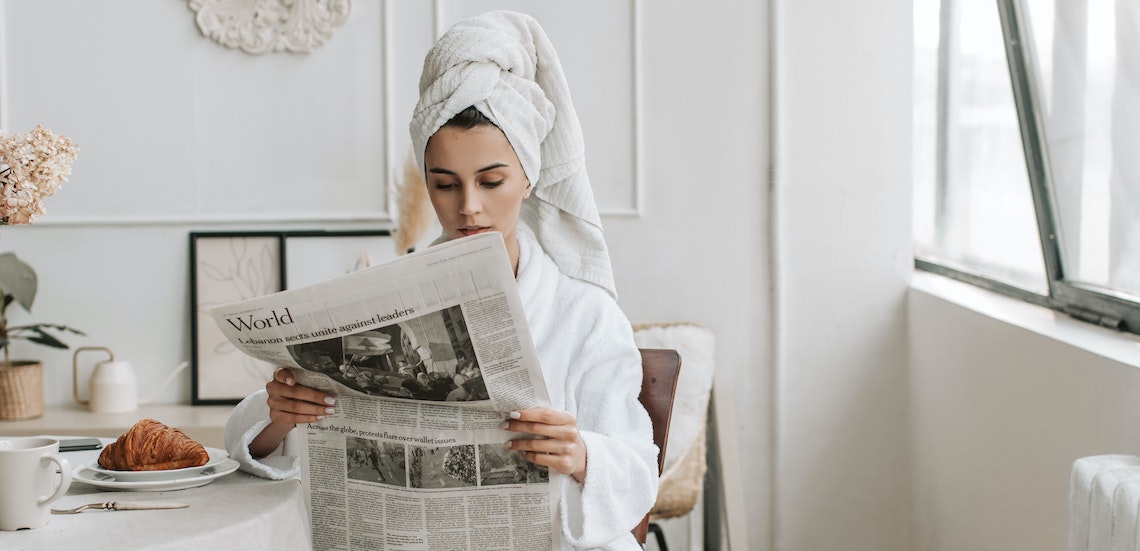In the beauty industry, there is a constant arms race in the digital world to attract the attention of editors, influencers and customers alike. But some brands are embracing offline opportunities in the form of zines to encourage quiet moments of engagement.
Zines are mini, self-published magazines, typically with a small distribution of physical copies and a focus on unconventional subject matter. Zines gained mega-popularity in the ’70s punk scene. But in the case of 2021 and the beauty industry, zines provide brands a light-hearted opportunity to provide customers with an extra perk or to gain social media posts from editors and influencers. For example, in March 2021, Selena Gomez’s Rare Beauty brand partnered with established zine All My Friends, and in August, when Rose Inc. launched, its press mailers included a printed large-scale zine. More recently, both hair-care brand Bread Beauty Supply and clean makeup brand Saie produced periodic zines to story-tell to influencers and editors. Now, both are expanding the distribution to e-commerce customers.
Saie launched its third zine in September after sending its first in Spring 2020. The theme of the zine is based on travel, to correspond with the marketing for the brand’s new shades of Slip Tint tinted moisturizer, launched on Wednesday. Slip Tint was designed to be travel-friendly. Titled “Let’s Go,” the zine includes travel guides for four cities, including Miami and L.A., alongside art illustrations and playlists curated by local DJs, with QR codes for easy access.
Laney Crowell, Saie founder and CEO, previously worked at magazines including Elle and Lucky before going full-time into beauty with Estée Lauder Companies. Suffice to say, the concept of a zine was not alien to Crowell. She wanted to emphasize storytelling, given the brand launched in Nov. 2019, shortly before the emergence of Covid-19. It was unable to host immersive events or in-person meetings, as it originally planned.
Zines regained widespread attraction in mid-2020 during the U.S. quarantine as a form of creative expression, with many being “published” on Instagram.
“We found that people were saving [our zines], which was why we decided to have maps in this new one. We thought about the type of things we hold onto once we [have] them,” said Crowell. “Any lifestyle elements all go back to the product in some shape or form. It’s an editorial moment for us, in that this is simply for engagement and to bring life to the product.”
Crowell and the Saie team brainstorm the zines about two months in advance of publishing them, and all the creative production is done in-house. For the September issue, Saie produced 1,000 zines. Five hundred were sent to influencers, editors and friends of the brand, while the other 500 will be sent to the first 500 people who order the new Slip Tint shades.
Ad position: web_incontent_pos1
For Saie, the zines are also serving as a test for its upcoming direct mailing campaign, in October. It will reach 100,000 households and is being developed in-house. Saie is looking to see how many people access the QR codes in the zines, which link back to the brand’s website and the current edition’s musical playlist.
Bread Beauty Supply also produced an undisclosed number of zines (called “Daily Bread”) to include within its press and influencer mailers in Australia when the brand launched in the spring of 2020. Maeva Heim, Bread Beauty Supply founder, said the idea was inspired by a nostalgic morning routine of going to a bakery to buy fresh bread and pick up a morning newspaper. Bread replicated the zine, with different messaging, in June, when the brand launched its hair cream in the U.S. In September, Bread produced another zine to coincide with the launch of two new products on Tuesday: a scalp serum for $28 and a mud mask for $34 through Sephora.
View this post on Instagram
“It gave us the opportunity to tell people about the brand and the products, but also to include personal touches,” said Heim. “What we found was that people were excited to share it on their [Instagram] Stories. People share products on their Stories all the time, but to have the more tactile and fun element resonated with people.”
For example, Heim said that a bakery owner had seen the zine on social media and sent a request to Bread to send them a copy to post within the bakery. The zines included recipes, crosswords related to the products, a note from Heim and product how-tos. Bread plans to start including zines with e-commerce orders by November. It will also begin to add more editorial elements, including imagery and interviews with brand ambassadors. And it will update the zines every few months to keep them fresh for customers.
Ad position: web_incontent_pos2
“People, like editors and influences, get so overwhelmed with products, as everyone is being sent new products every day. It helps to kind of cut through that noise and give us an opportunity to get people to retain information,” said Heim.


